Evaluating People Management and HR Practices at NHS, UK
VerifiedAdded on 2023/01/12
|9
|2442
|69
Report
AI Summary
This report provides an overview of people management practices within the National Health Service (NHS) in the UK, focusing on key Human Resources functions such as leadership and management, training and development (T&D), and talent management. It examines relevant theoretical models like Contingency Theory, Transitional Model, and Expectancy Theory, and their application within the NHS context. The report also discusses the roles and priorities of NHS management, highlighting functions like recruitment, training, employee relations, and the internal and external influences impacting leadership, T&D, and talent management. Internal factors include organizational resources and the working environment, while external factors encompass social elements, healthcare regulations, and market demand and supply. The report concludes with recommendations for NHS executives to enhance leadership styles, improve training programs, and strengthen talent management strategies.
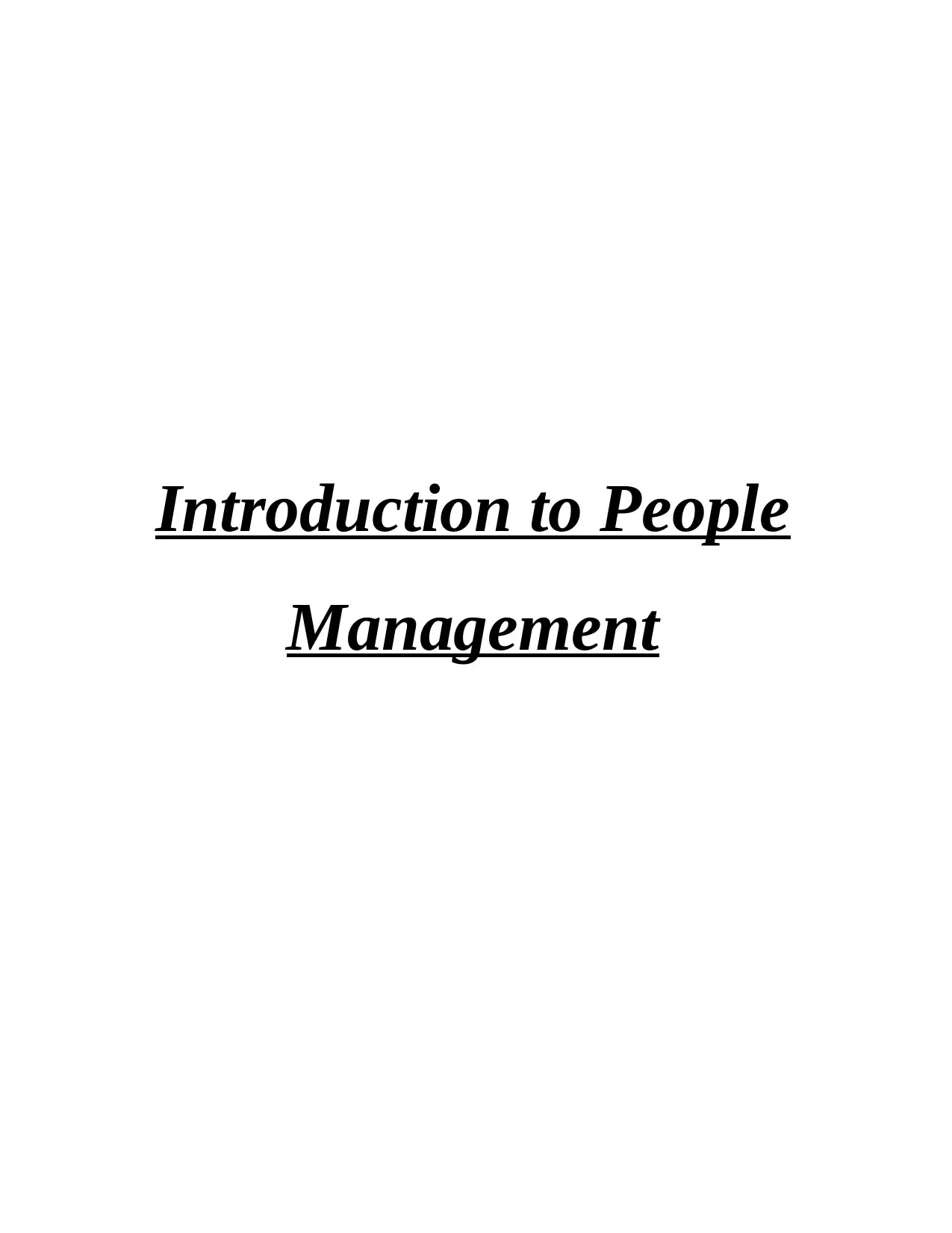
Introduction to People
Management
Management
Paraphrase This Document
Need a fresh take? Get an instant paraphrase of this document with our AI Paraphraser
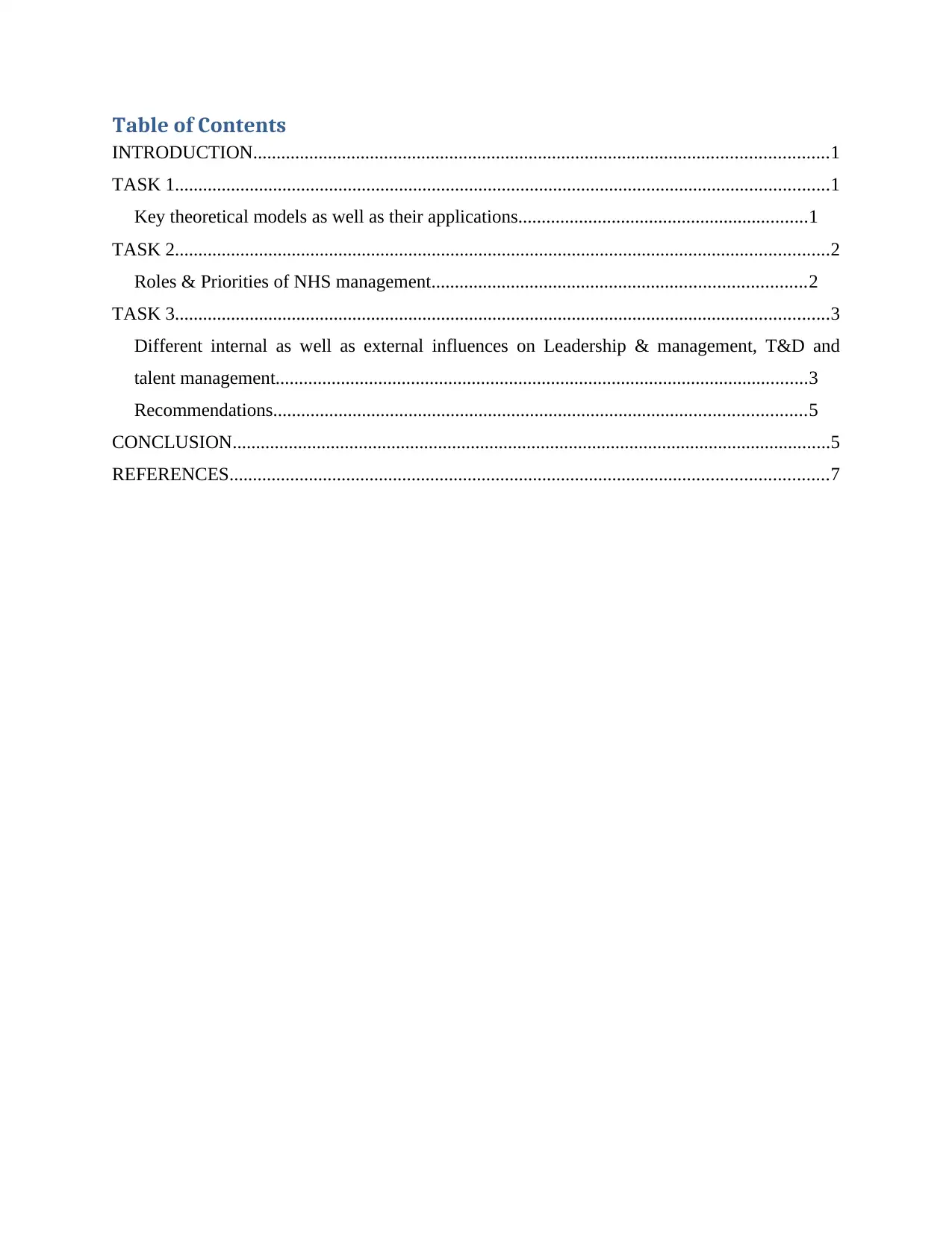
Table of Contents
INTRODUCTION...........................................................................................................................1
TASK 1............................................................................................................................................1
Key theoretical models as well as their applications..............................................................1
TASK 2............................................................................................................................................2
Roles & Priorities of NHS management................................................................................2
TASK 3............................................................................................................................................3
Different internal as well as external influences on Leadership & management, T&D and
talent management..................................................................................................................3
Recommendations..................................................................................................................5
CONCLUSION................................................................................................................................5
REFERENCES................................................................................................................................7
INTRODUCTION...........................................................................................................................1
TASK 1............................................................................................................................................1
Key theoretical models as well as their applications..............................................................1
TASK 2............................................................................................................................................2
Roles & Priorities of NHS management................................................................................2
TASK 3............................................................................................................................................3
Different internal as well as external influences on Leadership & management, T&D and
talent management..................................................................................................................3
Recommendations..................................................................................................................5
CONCLUSION................................................................................................................................5
REFERENCES................................................................................................................................7
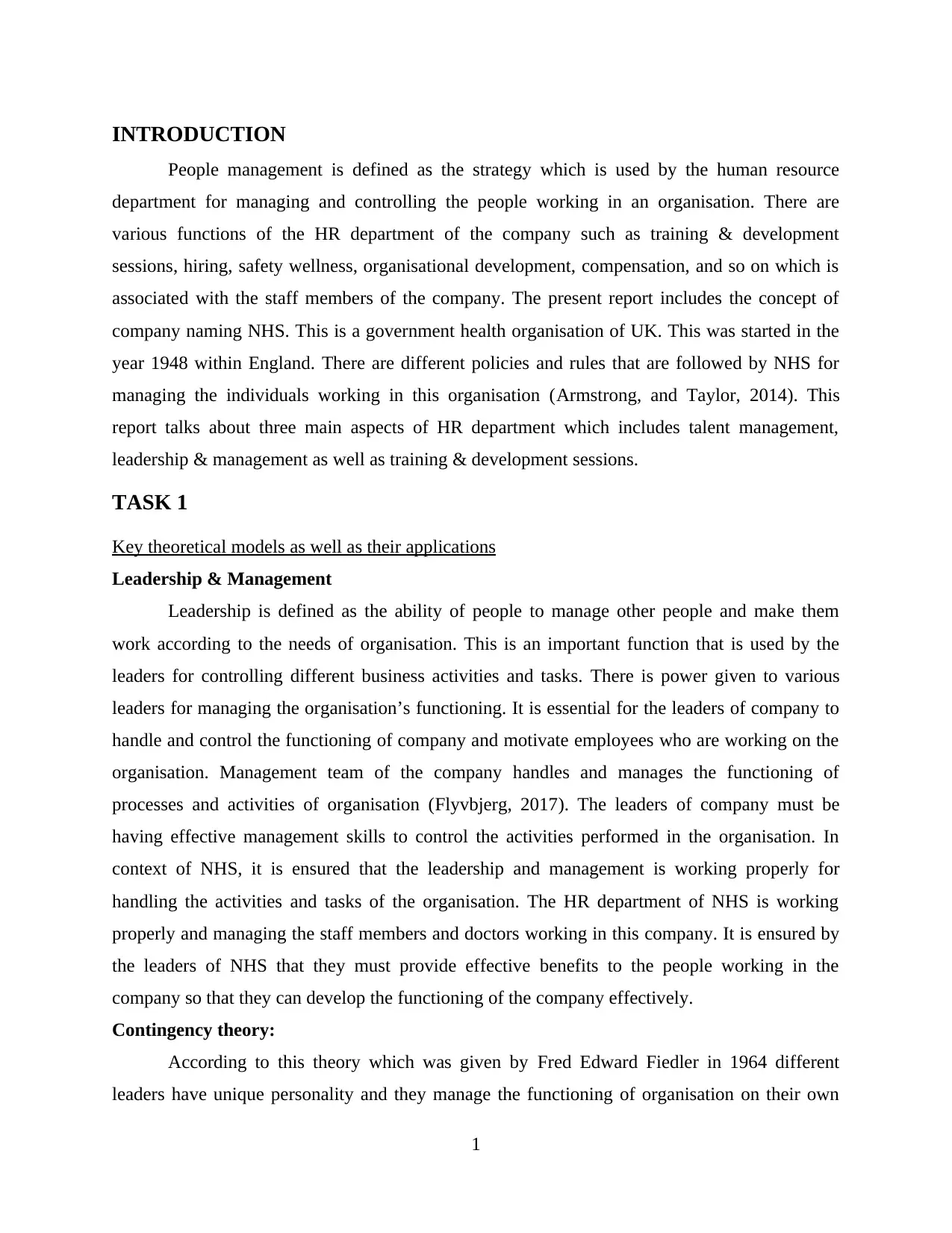
INTRODUCTION
People management is defined as the strategy which is used by the human resource
department for managing and controlling the people working in an organisation. There are
various functions of the HR department of the company such as training & development
sessions, hiring, safety wellness, organisational development, compensation, and so on which is
associated with the staff members of the company. The present report includes the concept of
company naming NHS. This is a government health organisation of UK. This was started in the
year 1948 within England. There are different policies and rules that are followed by NHS for
managing the individuals working in this organisation (Armstrong, and Taylor, 2014). This
report talks about three main aspects of HR department which includes talent management,
leadership & management as well as training & development sessions.
TASK 1
Key theoretical models as well as their applications
Leadership & Management
Leadership is defined as the ability of people to manage other people and make them
work according to the needs of organisation. This is an important function that is used by the
leaders for controlling different business activities and tasks. There is power given to various
leaders for managing the organisation’s functioning. It is essential for the leaders of company to
handle and control the functioning of company and motivate employees who are working on the
organisation. Management team of the company handles and manages the functioning of
processes and activities of organisation (Flyvbjerg, 2017). The leaders of company must be
having effective management skills to control the activities performed in the organisation. In
context of NHS, it is ensured that the leadership and management is working properly for
handling the activities and tasks of the organisation. The HR department of NHS is working
properly and managing the staff members and doctors working in this company. It is ensured by
the leaders of NHS that they must provide effective benefits to the people working in the
company so that they can develop the functioning of the company effectively.
Contingency theory:
According to this theory which was given by Fred Edward Fiedler in 1964 different
leaders have unique personality and they manage the functioning of organisation on their own
1
People management is defined as the strategy which is used by the human resource
department for managing and controlling the people working in an organisation. There are
various functions of the HR department of the company such as training & development
sessions, hiring, safety wellness, organisational development, compensation, and so on which is
associated with the staff members of the company. The present report includes the concept of
company naming NHS. This is a government health organisation of UK. This was started in the
year 1948 within England. There are different policies and rules that are followed by NHS for
managing the individuals working in this organisation (Armstrong, and Taylor, 2014). This
report talks about three main aspects of HR department which includes talent management,
leadership & management as well as training & development sessions.
TASK 1
Key theoretical models as well as their applications
Leadership & Management
Leadership is defined as the ability of people to manage other people and make them
work according to the needs of organisation. This is an important function that is used by the
leaders for controlling different business activities and tasks. There is power given to various
leaders for managing the organisation’s functioning. It is essential for the leaders of company to
handle and control the functioning of company and motivate employees who are working on the
organisation. Management team of the company handles and manages the functioning of
processes and activities of organisation (Flyvbjerg, 2017). The leaders of company must be
having effective management skills to control the activities performed in the organisation. In
context of NHS, it is ensured that the leadership and management is working properly for
handling the activities and tasks of the organisation. The HR department of NHS is working
properly and managing the staff members and doctors working in this company. It is ensured by
the leaders of NHS that they must provide effective benefits to the people working in the
company so that they can develop the functioning of the company effectively.
Contingency theory:
According to this theory which was given by Fred Edward Fiedler in 1964 different
leaders have unique personality and they manage the functioning of organisation on their own
1
⊘ This is a preview!⊘
Do you want full access?
Subscribe today to unlock all pages.

Trusted by 1+ million students worldwide
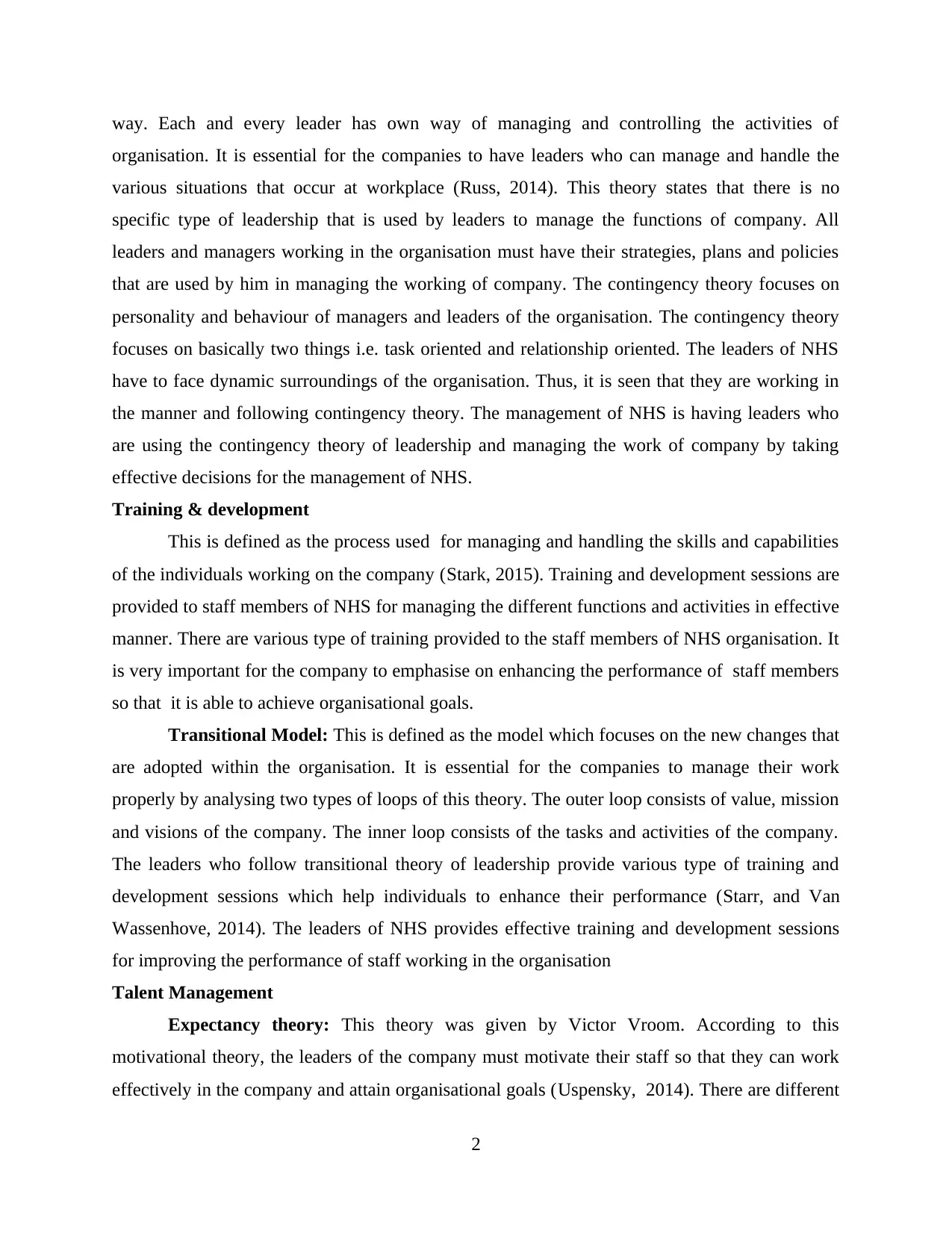
way. Each and every leader has own way of managing and controlling the activities of
organisation. It is essential for the companies to have leaders who can manage and handle the
various situations that occur at workplace (Russ, 2014). This theory states that there is no
specific type of leadership that is used by leaders to manage the functions of company. All
leaders and managers working in the organisation must have their strategies, plans and policies
that are used by him in managing the working of company. The contingency theory focuses on
personality and behaviour of managers and leaders of the organisation. The contingency theory
focuses on basically two things i.e. task oriented and relationship oriented. The leaders of NHS
have to face dynamic surroundings of the organisation. Thus, it is seen that they are working in
the manner and following contingency theory. The management of NHS is having leaders who
are using the contingency theory of leadership and managing the work of company by taking
effective decisions for the management of NHS.
Training & development
This is defined as the process used for managing and handling the skills and capabilities
of the individuals working on the company (Stark, 2015). Training and development sessions are
provided to staff members of NHS for managing the different functions and activities in effective
manner. There are various type of training provided to the staff members of NHS organisation. It
is very important for the company to emphasise on enhancing the performance of staff members
so that it is able to achieve organisational goals.
Transitional Model: This is defined as the model which focuses on the new changes that
are adopted within the organisation. It is essential for the companies to manage their work
properly by analysing two types of loops of this theory. The outer loop consists of value, mission
and visions of the company. The inner loop consists of the tasks and activities of the company.
The leaders who follow transitional theory of leadership provide various type of training and
development sessions which help individuals to enhance their performance (Starr, and Van
Wassenhove, 2014). The leaders of NHS provides effective training and development sessions
for improving the performance of staff working in the organisation
Talent Management
Expectancy theory: This theory was given by Victor Vroom. According to this
motivational theory, the leaders of the company must motivate their staff so that they can work
effectively in the company and attain organisational goals (Uspensky, 2014). There are different
2
organisation. It is essential for the companies to have leaders who can manage and handle the
various situations that occur at workplace (Russ, 2014). This theory states that there is no
specific type of leadership that is used by leaders to manage the functions of company. All
leaders and managers working in the organisation must have their strategies, plans and policies
that are used by him in managing the working of company. The contingency theory focuses on
personality and behaviour of managers and leaders of the organisation. The contingency theory
focuses on basically two things i.e. task oriented and relationship oriented. The leaders of NHS
have to face dynamic surroundings of the organisation. Thus, it is seen that they are working in
the manner and following contingency theory. The management of NHS is having leaders who
are using the contingency theory of leadership and managing the work of company by taking
effective decisions for the management of NHS.
Training & development
This is defined as the process used for managing and handling the skills and capabilities
of the individuals working on the company (Stark, 2015). Training and development sessions are
provided to staff members of NHS for managing the different functions and activities in effective
manner. There are various type of training provided to the staff members of NHS organisation. It
is very important for the company to emphasise on enhancing the performance of staff members
so that it is able to achieve organisational goals.
Transitional Model: This is defined as the model which focuses on the new changes that
are adopted within the organisation. It is essential for the companies to manage their work
properly by analysing two types of loops of this theory. The outer loop consists of value, mission
and visions of the company. The inner loop consists of the tasks and activities of the company.
The leaders who follow transitional theory of leadership provide various type of training and
development sessions which help individuals to enhance their performance (Starr, and Van
Wassenhove, 2014). The leaders of NHS provides effective training and development sessions
for improving the performance of staff working in the organisation
Talent Management
Expectancy theory: This theory was given by Victor Vroom. According to this
motivational theory, the leaders of the company must motivate their staff so that they can work
effectively in the company and attain organisational goals (Uspensky, 2014). There are different
2
Paraphrase This Document
Need a fresh take? Get an instant paraphrase of this document with our AI Paraphraser
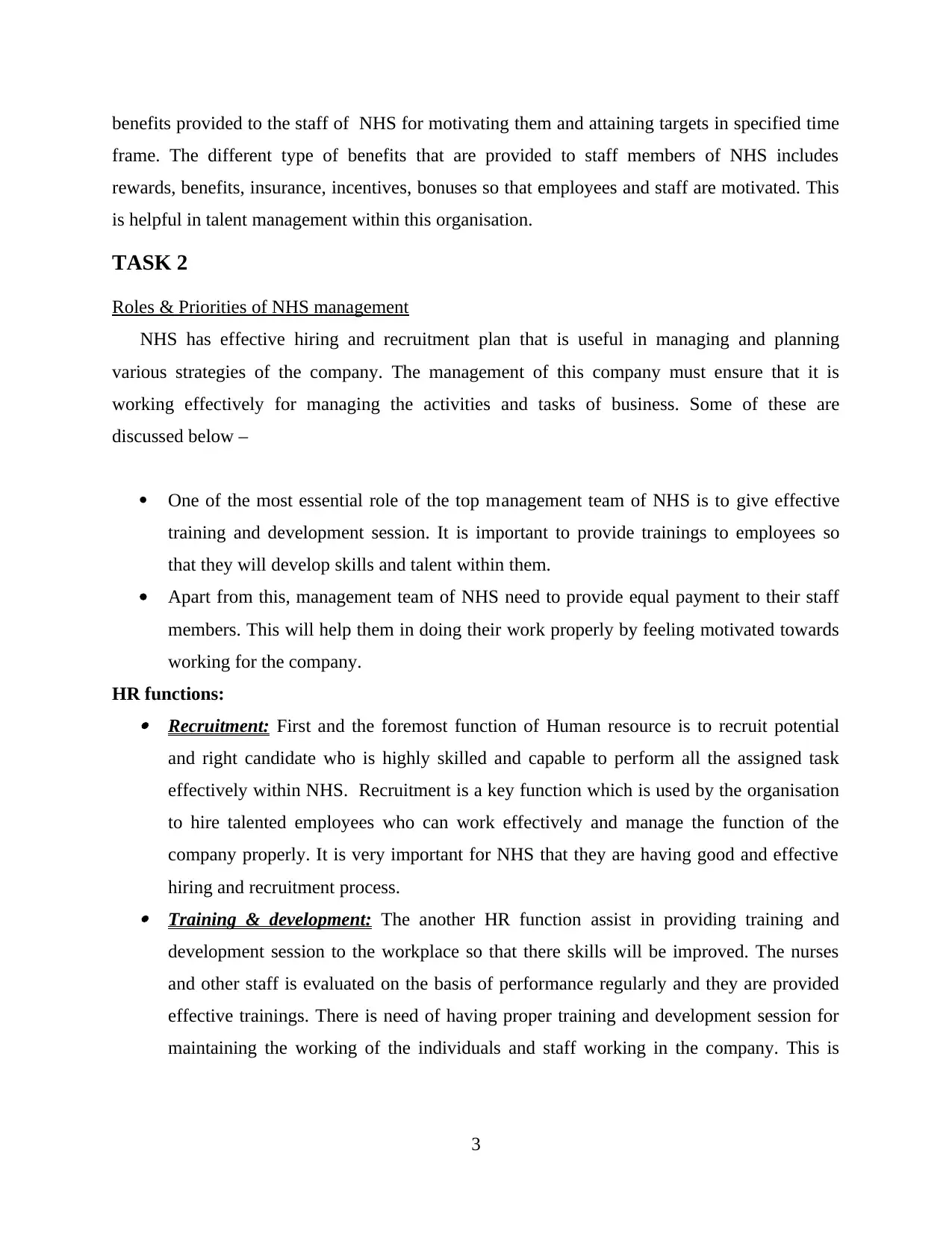
benefits provided to the staff of NHS for motivating them and attaining targets in specified time
frame. The different type of benefits that are provided to staff members of NHS includes
rewards, benefits, insurance, incentives, bonuses so that employees and staff are motivated. This
is helpful in talent management within this organisation.
TASK 2
Roles & Priorities of NHS management
NHS has effective hiring and recruitment plan that is useful in managing and planning
various strategies of the company. The management of this company must ensure that it is
working effectively for managing the activities and tasks of business. Some of these are
discussed below –
One of the most essential role of the top management team of NHS is to give effective
training and development session. It is important to provide trainings to employees so
that they will develop skills and talent within them.
Apart from this, management team of NHS need to provide equal payment to their staff
members. This will help them in doing their work properly by feeling motivated towards
working for the company.
HR functions: Recruitment: First and the foremost function of Human resource is to recruit potential
and right candidate who is highly skilled and capable to perform all the assigned task
effectively within NHS. Recruitment is a key function which is used by the organisation
to hire talented employees who can work effectively and manage the function of the
company properly. It is very important for NHS that they are having good and effective
hiring and recruitment process. Training & development: The another HR function assist in providing training and
development session to the workplace so that there skills will be improved. The nurses
and other staff is evaluated on the basis of performance regularly and they are provided
effective trainings. There is need of having proper training and development session for
maintaining the working of the individuals and staff working in the company. This is
3
frame. The different type of benefits that are provided to staff members of NHS includes
rewards, benefits, insurance, incentives, bonuses so that employees and staff are motivated. This
is helpful in talent management within this organisation.
TASK 2
Roles & Priorities of NHS management
NHS has effective hiring and recruitment plan that is useful in managing and planning
various strategies of the company. The management of this company must ensure that it is
working effectively for managing the activities and tasks of business. Some of these are
discussed below –
One of the most essential role of the top management team of NHS is to give effective
training and development session. It is important to provide trainings to employees so
that they will develop skills and talent within them.
Apart from this, management team of NHS need to provide equal payment to their staff
members. This will help them in doing their work properly by feeling motivated towards
working for the company.
HR functions: Recruitment: First and the foremost function of Human resource is to recruit potential
and right candidate who is highly skilled and capable to perform all the assigned task
effectively within NHS. Recruitment is a key function which is used by the organisation
to hire talented employees who can work effectively and manage the function of the
company properly. It is very important for NHS that they are having good and effective
hiring and recruitment process. Training & development: The another HR function assist in providing training and
development session to the workplace so that there skills will be improved. The nurses
and other staff is evaluated on the basis of performance regularly and they are provided
effective trainings. There is need of having proper training and development session for
maintaining the working of the individuals and staff working in the company. This is
3
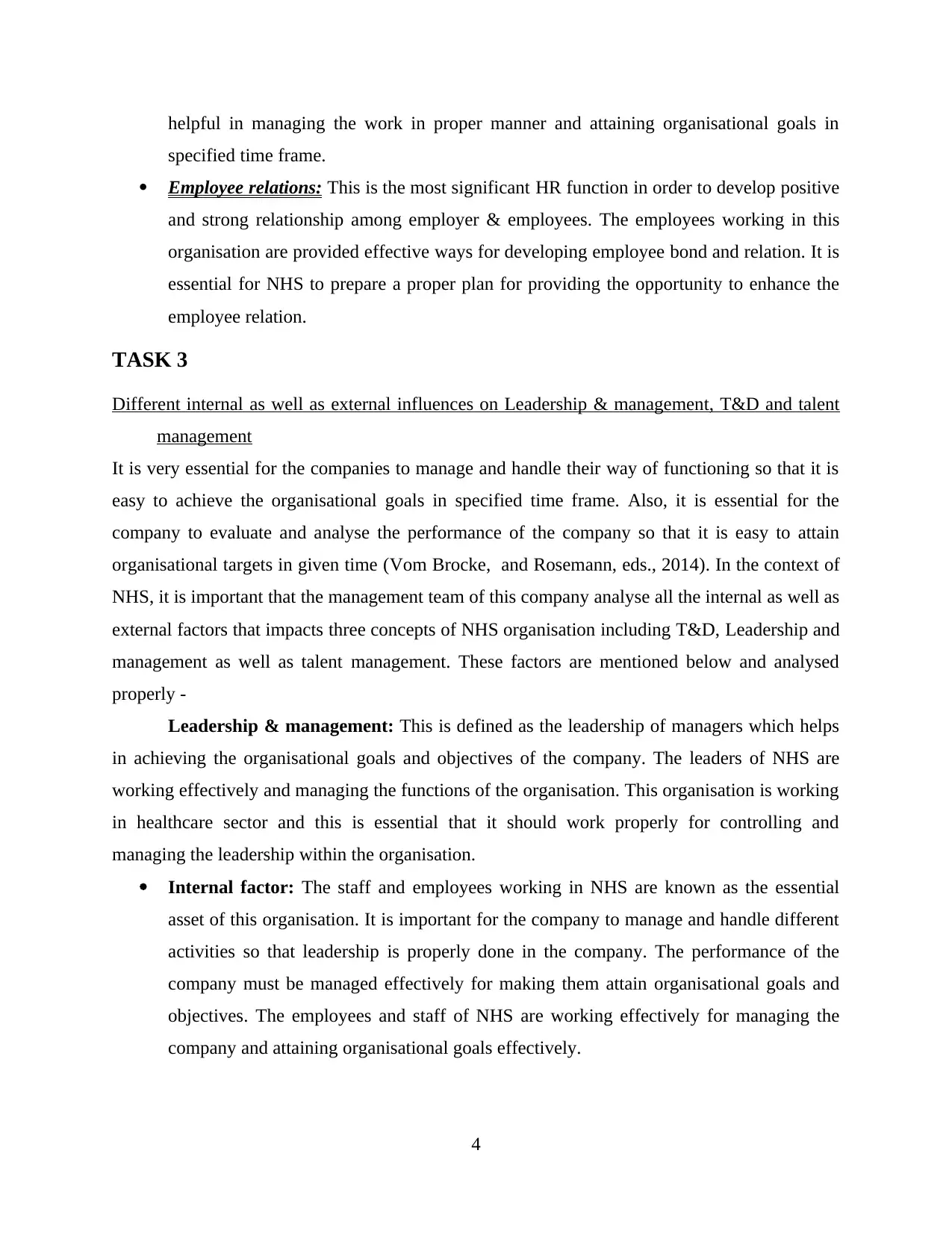
helpful in managing the work in proper manner and attaining organisational goals in
specified time frame.
Employee relations: This is the most significant HR function in order to develop positive
and strong relationship among employer & employees. The employees working in this
organisation are provided effective ways for developing employee bond and relation. It is
essential for NHS to prepare a proper plan for providing the opportunity to enhance the
employee relation.
TASK 3
Different internal as well as external influences on Leadership & management, T&D and talent
management
It is very essential for the companies to manage and handle their way of functioning so that it is
easy to achieve the organisational goals in specified time frame. Also, it is essential for the
company to evaluate and analyse the performance of the company so that it is easy to attain
organisational targets in given time (Vom Brocke, and Rosemann, eds., 2014). In the context of
NHS, it is important that the management team of this company analyse all the internal as well as
external factors that impacts three concepts of NHS organisation including T&D, Leadership and
management as well as talent management. These factors are mentioned below and analysed
properly -
Leadership & management: This is defined as the leadership of managers which helps
in achieving the organisational goals and objectives of the company. The leaders of NHS are
working effectively and managing the functions of the organisation. This organisation is working
in healthcare sector and this is essential that it should work properly for controlling and
managing the leadership within the organisation.
Internal factor: The staff and employees working in NHS are known as the essential
asset of this organisation. It is important for the company to manage and handle different
activities so that leadership is properly done in the company. The performance of the
company must be managed effectively for making them attain organisational goals and
objectives. The employees and staff of NHS are working effectively for managing the
company and attaining organisational goals effectively.
4
specified time frame.
Employee relations: This is the most significant HR function in order to develop positive
and strong relationship among employer & employees. The employees working in this
organisation are provided effective ways for developing employee bond and relation. It is
essential for NHS to prepare a proper plan for providing the opportunity to enhance the
employee relation.
TASK 3
Different internal as well as external influences on Leadership & management, T&D and talent
management
It is very essential for the companies to manage and handle their way of functioning so that it is
easy to achieve the organisational goals in specified time frame. Also, it is essential for the
company to evaluate and analyse the performance of the company so that it is easy to attain
organisational targets in given time (Vom Brocke, and Rosemann, eds., 2014). In the context of
NHS, it is important that the management team of this company analyse all the internal as well as
external factors that impacts three concepts of NHS organisation including T&D, Leadership and
management as well as talent management. These factors are mentioned below and analysed
properly -
Leadership & management: This is defined as the leadership of managers which helps
in achieving the organisational goals and objectives of the company. The leaders of NHS are
working effectively and managing the functions of the organisation. This organisation is working
in healthcare sector and this is essential that it should work properly for controlling and
managing the leadership within the organisation.
Internal factor: The staff and employees working in NHS are known as the essential
asset of this organisation. It is important for the company to manage and handle different
activities so that leadership is properly done in the company. The performance of the
company must be managed effectively for making them attain organisational goals and
objectives. The employees and staff of NHS are working effectively for managing the
company and attaining organisational goals effectively.
4
⊘ This is a preview!⊘
Do you want full access?
Subscribe today to unlock all pages.

Trusted by 1+ million students worldwide
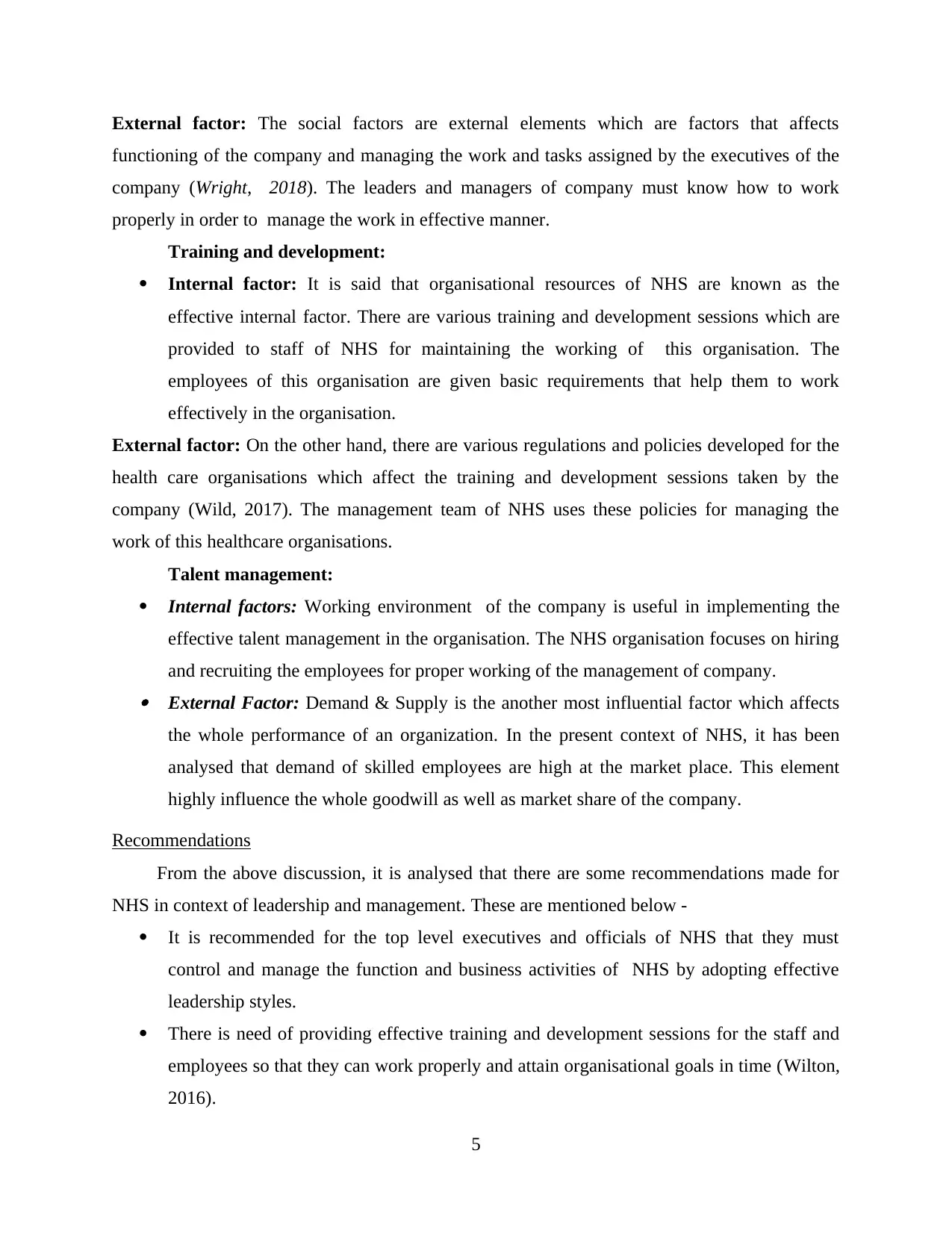
External factor: The social factors are external elements which are factors that affects
functioning of the company and managing the work and tasks assigned by the executives of the
company (Wright, 2018). The leaders and managers of company must know how to work
properly in order to manage the work in effective manner.
Training and development:
Internal factor: It is said that organisational resources of NHS are known as the
effective internal factor. There are various training and development sessions which are
provided to staff of NHS for maintaining the working of this organisation. The
employees of this organisation are given basic requirements that help them to work
effectively in the organisation.
External factor: On the other hand, there are various regulations and policies developed for the
health care organisations which affect the training and development sessions taken by the
company (Wild, 2017). The management team of NHS uses these policies for managing the
work of this healthcare organisations.
Talent management:
Internal factors: Working environment of the company is useful in implementing the
effective talent management in the organisation. The NHS organisation focuses on hiring
and recruiting the employees for proper working of the management of company. External Factor: Demand & Supply is the another most influential factor which affects
the whole performance of an organization. In the present context of NHS, it has been
analysed that demand of skilled employees are high at the market place. This element
highly influence the whole goodwill as well as market share of the company.
Recommendations
From the above discussion, it is analysed that there are some recommendations made for
NHS in context of leadership and management. These are mentioned below -
It is recommended for the top level executives and officials of NHS that they must
control and manage the function and business activities of NHS by adopting effective
leadership styles.
There is need of providing effective training and development sessions for the staff and
employees so that they can work properly and attain organisational goals in time (Wilton,
2016).
5
functioning of the company and managing the work and tasks assigned by the executives of the
company (Wright, 2018). The leaders and managers of company must know how to work
properly in order to manage the work in effective manner.
Training and development:
Internal factor: It is said that organisational resources of NHS are known as the
effective internal factor. There are various training and development sessions which are
provided to staff of NHS for maintaining the working of this organisation. The
employees of this organisation are given basic requirements that help them to work
effectively in the organisation.
External factor: On the other hand, there are various regulations and policies developed for the
health care organisations which affect the training and development sessions taken by the
company (Wild, 2017). The management team of NHS uses these policies for managing the
work of this healthcare organisations.
Talent management:
Internal factors: Working environment of the company is useful in implementing the
effective talent management in the organisation. The NHS organisation focuses on hiring
and recruiting the employees for proper working of the management of company. External Factor: Demand & Supply is the another most influential factor which affects
the whole performance of an organization. In the present context of NHS, it has been
analysed that demand of skilled employees are high at the market place. This element
highly influence the whole goodwill as well as market share of the company.
Recommendations
From the above discussion, it is analysed that there are some recommendations made for
NHS in context of leadership and management. These are mentioned below -
It is recommended for the top level executives and officials of NHS that they must
control and manage the function and business activities of NHS by adopting effective
leadership styles.
There is need of providing effective training and development sessions for the staff and
employees so that they can work properly and attain organisational goals in time (Wilton,
2016).
5
Paraphrase This Document
Need a fresh take? Get an instant paraphrase of this document with our AI Paraphraser
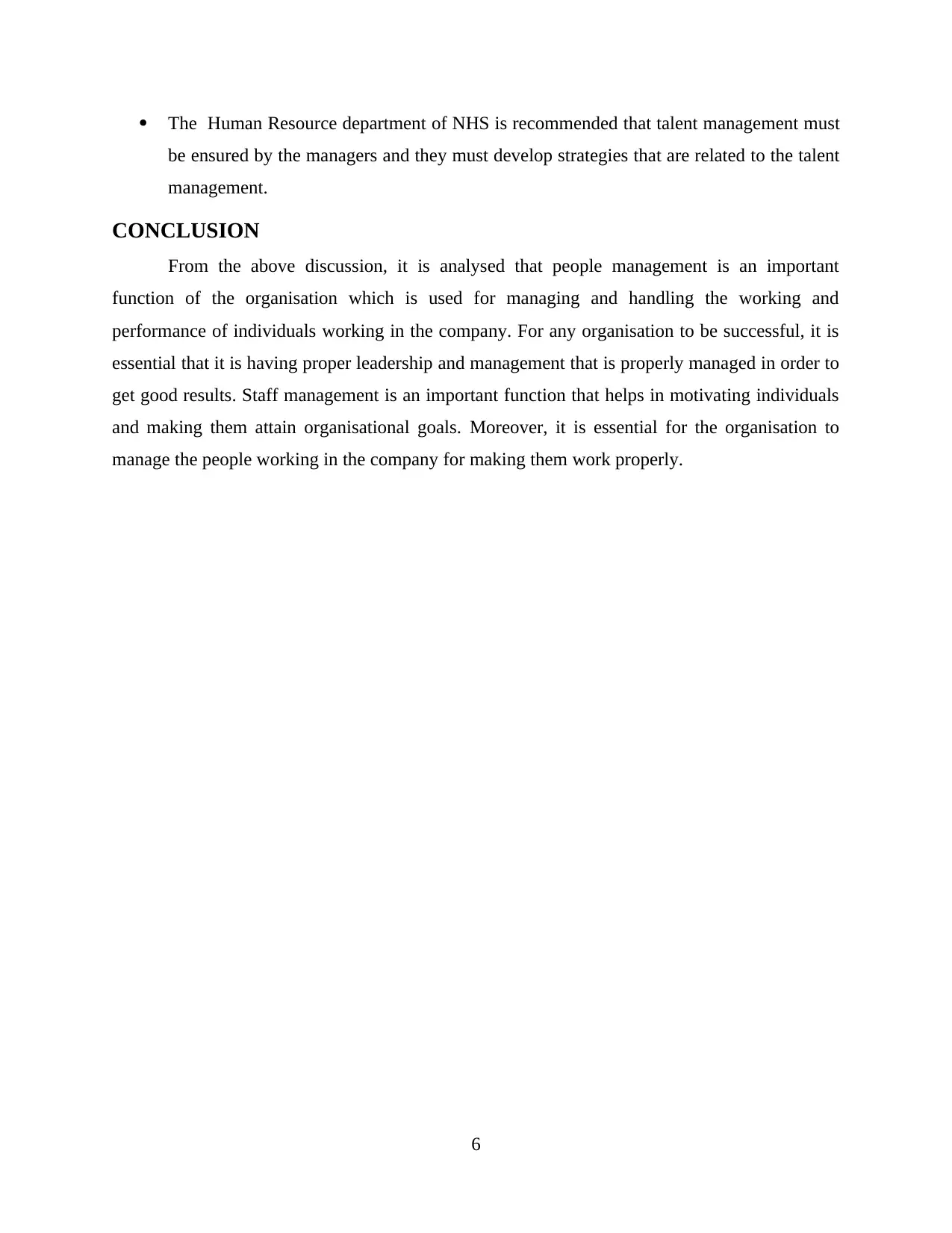
The Human Resource department of NHS is recommended that talent management must
be ensured by the managers and they must develop strategies that are related to the talent
management.
CONCLUSION
From the above discussion, it is analysed that people management is an important
function of the organisation which is used for managing and handling the working and
performance of individuals working in the company. For any organisation to be successful, it is
essential that it is having proper leadership and management that is properly managed in order to
get good results. Staff management is an important function that helps in motivating individuals
and making them attain organisational goals. Moreover, it is essential for the organisation to
manage the people working in the company for making them work properly.
6
be ensured by the managers and they must develop strategies that are related to the talent
management.
CONCLUSION
From the above discussion, it is analysed that people management is an important
function of the organisation which is used for managing and handling the working and
performance of individuals working in the company. For any organisation to be successful, it is
essential that it is having proper leadership and management that is properly managed in order to
get good results. Staff management is an important function that helps in motivating individuals
and making them attain organisational goals. Moreover, it is essential for the organisation to
manage the people working in the company for making them work properly.
6
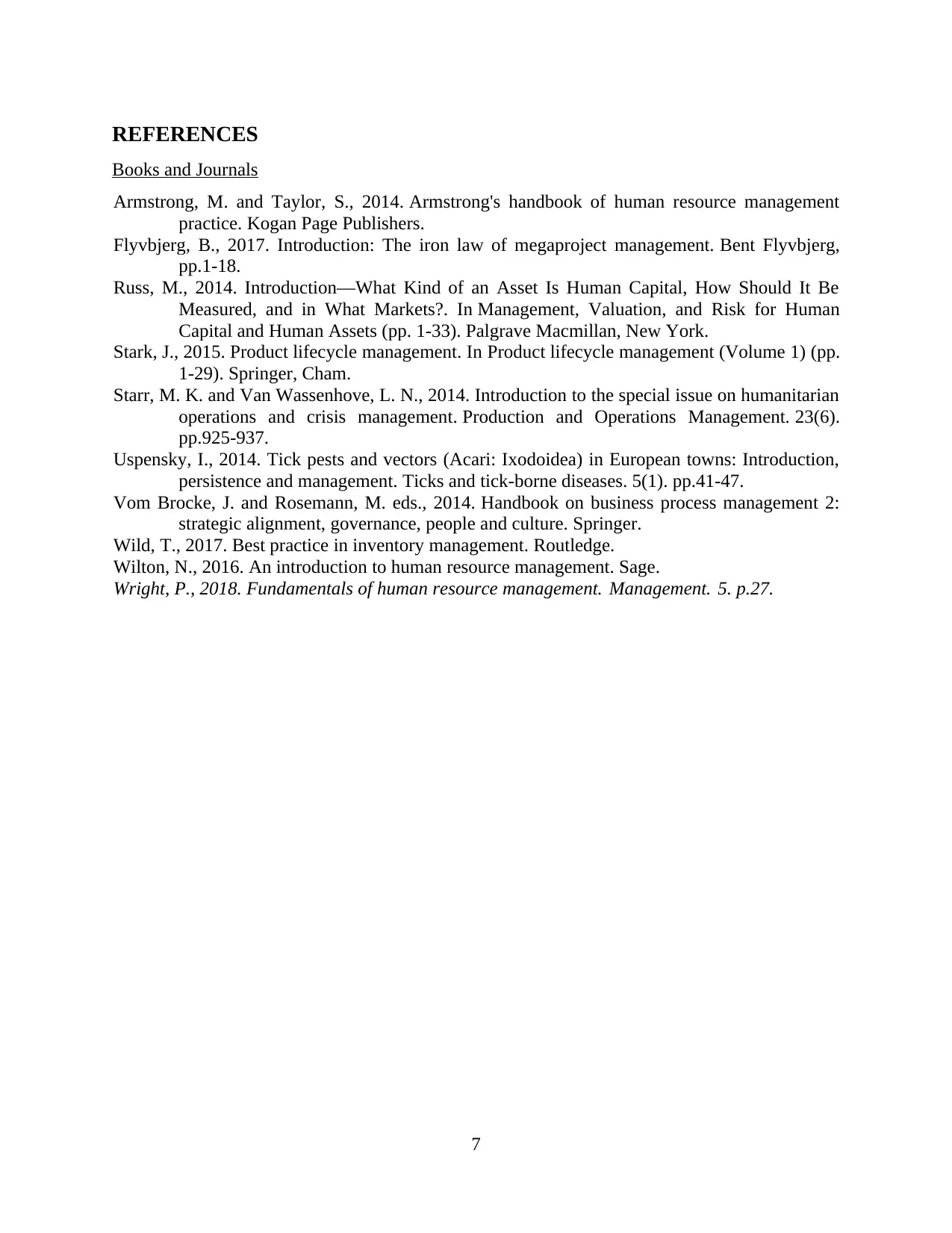
REFERENCES
Books and Journals
Armstrong, M. and Taylor, S., 2014. Armstrong's handbook of human resource management
practice. Kogan Page Publishers.
Flyvbjerg, B., 2017. Introduction: The iron law of megaproject management. Bent Flyvbjerg,
pp.1-18.
Russ, M., 2014. Introduction—What Kind of an Asset Is Human Capital, How Should It Be
Measured, and in What Markets?. In Management, Valuation, and Risk for Human
Capital and Human Assets (pp. 1-33). Palgrave Macmillan, New York.
Stark, J., 2015. Product lifecycle management. In Product lifecycle management (Volume 1) (pp.
1-29). Springer, Cham.
Starr, M. K. and Van Wassenhove, L. N., 2014. Introduction to the special issue on humanitarian
operations and crisis management. Production and Operations Management. 23(6).
pp.925-937.
Uspensky, I., 2014. Tick pests and vectors (Acari: Ixodoidea) in European towns: Introduction,
persistence and management. Ticks and tick-borne diseases. 5(1). pp.41-47.
Vom Brocke, J. and Rosemann, M. eds., 2014. Handbook on business process management 2:
strategic alignment, governance, people and culture. Springer.
Wild, T., 2017. Best practice in inventory management. Routledge.
Wilton, N., 2016. An introduction to human resource management. Sage.
Wright, P., 2018. Fundamentals of human resource management. Management. 5. p.27.
7
Books and Journals
Armstrong, M. and Taylor, S., 2014. Armstrong's handbook of human resource management
practice. Kogan Page Publishers.
Flyvbjerg, B., 2017. Introduction: The iron law of megaproject management. Bent Flyvbjerg,
pp.1-18.
Russ, M., 2014. Introduction—What Kind of an Asset Is Human Capital, How Should It Be
Measured, and in What Markets?. In Management, Valuation, and Risk for Human
Capital and Human Assets (pp. 1-33). Palgrave Macmillan, New York.
Stark, J., 2015. Product lifecycle management. In Product lifecycle management (Volume 1) (pp.
1-29). Springer, Cham.
Starr, M. K. and Van Wassenhove, L. N., 2014. Introduction to the special issue on humanitarian
operations and crisis management. Production and Operations Management. 23(6).
pp.925-937.
Uspensky, I., 2014. Tick pests and vectors (Acari: Ixodoidea) in European towns: Introduction,
persistence and management. Ticks and tick-borne diseases. 5(1). pp.41-47.
Vom Brocke, J. and Rosemann, M. eds., 2014. Handbook on business process management 2:
strategic alignment, governance, people and culture. Springer.
Wild, T., 2017. Best practice in inventory management. Routledge.
Wilton, N., 2016. An introduction to human resource management. Sage.
Wright, P., 2018. Fundamentals of human resource management. Management. 5. p.27.
7
⊘ This is a preview!⊘
Do you want full access?
Subscribe today to unlock all pages.

Trusted by 1+ million students worldwide
1 out of 9
Related Documents
Your All-in-One AI-Powered Toolkit for Academic Success.
+13062052269
info@desklib.com
Available 24*7 on WhatsApp / Email
![[object Object]](/_next/static/media/star-bottom.7253800d.svg)
Unlock your academic potential
Copyright © 2020–2025 A2Z Services. All Rights Reserved. Developed and managed by ZUCOL.





